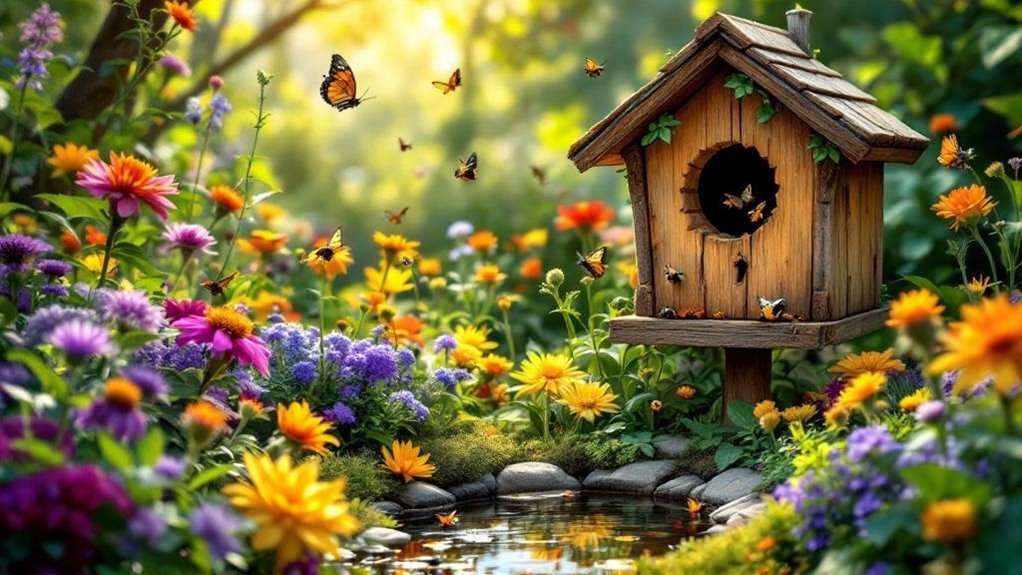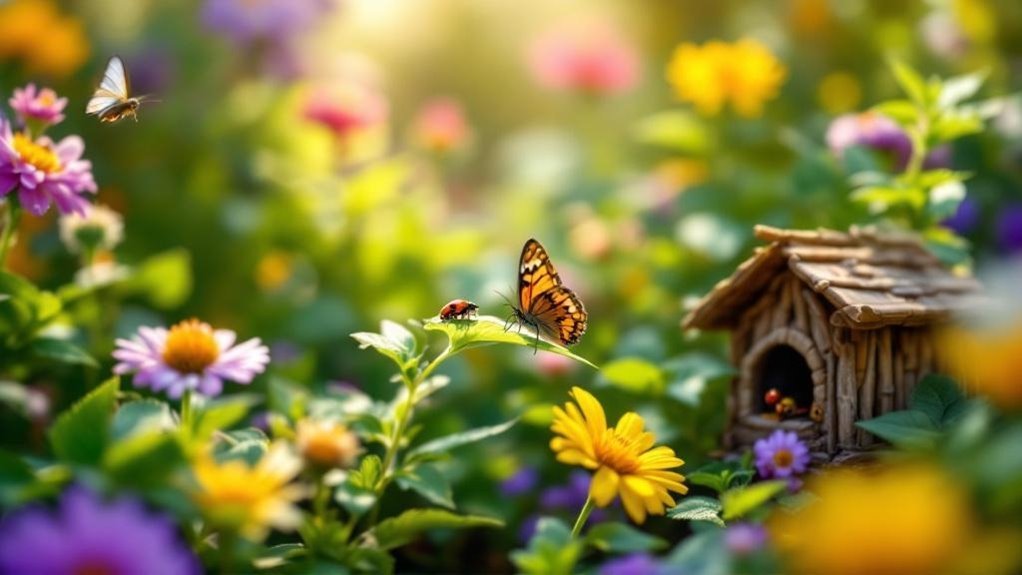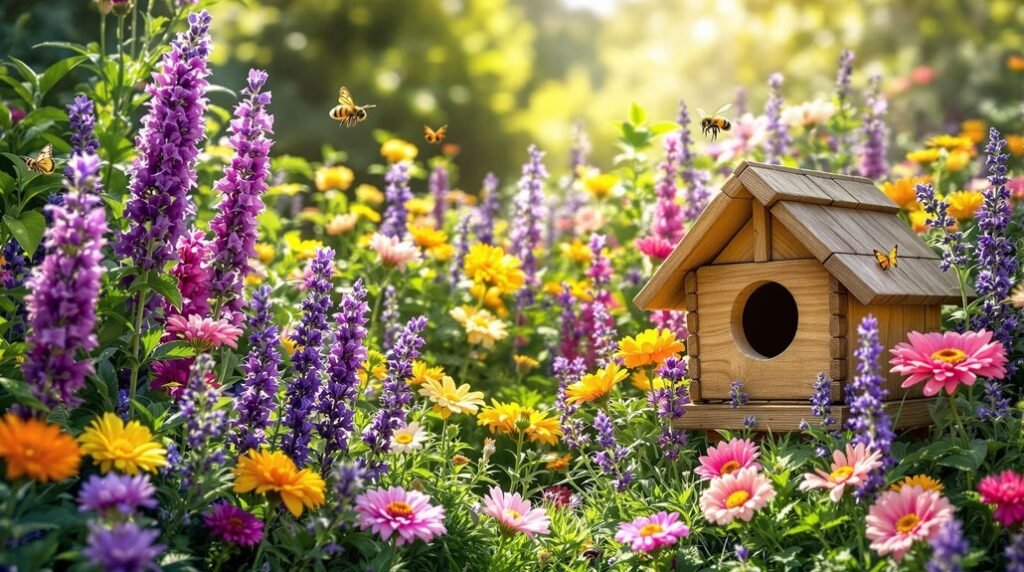If you want to improve your garden’s health naturally, attracting beneficial insects is a smart move. These insects help control pests and pollinate plants, reducing your need for chemicals. But it’s not just about planting flowers; you need to understand which species to invite, how to provide suitable habitats, and when to plant for year-round support. Before you start, consider what your garden currently lacks and how small changes can make a big difference.
Common Beneficial Insects in Your Garden
While you mightn’t always notice them, beneficial insects play a crucial role in keeping your garden healthy by controlling pests and aiding pollination.
Lady beetles, for example, can consume up to 5,000 aphids during their larval stage, making them powerful allies in pest management. Lacewings also help by feeding voraciously on caterpillars and aphids.
Hoverflies are valuable too; not only do they pollinate your flowering plants, but their larvae target aphids. Parasitic wasps provide natural pest control by laying eggs inside pests like hornworms, eventually eliminating the host.
Flower Families That Attract Beneficial Insects
Beneficial insects rely on specific flowers for nectar, pollen, and habitat, so choosing the right flower families can boost their presence in your garden.
By planting diverse flower families, you invite a variety of helpful bugs that naturally control pest populations. The Aster Family, like cosmos, attracts lady beetles that feast on pests.
The Carrot Family, including dill and fennel, draws parasitic wasps and flies that target harmful insects. Legumes such as clover support beneficial insects and enrich your soil.
The Mustard Family requires careful placement since it attracts both friends and foes. Don’t forget the Verbena Family, which lures many beneficial predators and pollinators.
- Welcome lady beetles with vibrant Aster Family blooms
- Encourage parasitic wasps via Carrot Family herbs
- Boost soil and insects with nitrogen-fixing legumes
- Use Mustard Family plants strategically to avoid pests
- Add Verbena flowers for diverse insect visitors
Creating Habitat for Beneficial Insects

A thriving garden depends on creating a welcoming habitat that supports helpful insects year-round. To attract beneficial insects, plant a diverse mix of annual and perennial flowers, shrubs, and cover crops like sweet alyssum that provide pollen and nectar continuously.
Incorporate flat-topped flowers such as yarrow and dill to offer easy access to nectar for smaller beneficials. Maintain natural growth areas with native plants to encourage natural enemies of pests to thrive.
Providing shallow water sources with pebbles helps beneficial insects hydrate safely. By designing your garden to offer shelter, food, and water, you create an inviting environment that attracts a wide variety of beneficial insects, boosting your garden’s health and resilience naturally.
Seasonal Planting for Continuous Support
To keep helpful insects visiting your garden all season, you need to plant a variety of flowers that bloom at different times.
Seasonal planting guarantees a continuous supply of nectar and pollen, essential for beneficial insects. By selecting plants from diverse families, like Asteraceae and Apiaceae, you attract beneficial insects with different preferences.
Monitor bloom schedules closely and adjust your plantings to match the life cycles of local pests, giving your garden natural protection when it’s most needed. Incorporate perennials and sequential herb plantings to maintain overlapping blooms, supporting beneficial insects throughout the season.
- Feel the joy as your garden buzzes with life all year
- Watch beneficial insects thrive with steady food sources
- Enjoy the beauty of diverse, colorful blooms
- Experience the satisfaction of natural pest control
- Connect deeply with nature’s rhythms through mindful planting
Protecting Beneficial Insects From Pesticides

Since pesticides can harm helpful insects more than the pests, you need to choose your treatments carefully to protect these garden allies.
Beneficial insects are often more sensitive to insecticides, so selecting products with little or no residual activity—like insecticidal soap, horticultural oil, or botanical insecticides—helps.
To reduce exposure, apply pesticides in the early morning or evening when beneficial insects are less active. Avoid broad-spectrum insecticides; instead, use targeted treatments that focus only on pests.
Integrating these practices into an integrated pest management approach lets you balance pest control while protecting beneficial insects.
Frequently Asked Questions
How to Introduce Beneficial Insects to the Garden?
You can introduce beneficial insects by planting diverse flowers that bloom throughout the season, avoiding harmful pesticides, providing shallow water sources, and allowing natural growth areas. These steps create a welcoming habitat for helpful insects in your garden.
What Flowers Attract Beneficial Insects?
Think of a garden as a buzzing symphony; plant carrot family blooms like dill to invite tiny guardians, asters like cosmos to welcome vigilant predators, and legumes for nourishing allies—each flower a note calling beneficial insects to dance.
How to Get Good Bugs in Your Garden?
You can get good bugs by planting diverse flowers like yarrow and alyssum, providing shallow water dishes, avoiding broad pesticides, and allowing some natural growth. This creates a welcoming habitat for beneficial insects in your garden.
What Are the Three P’s of Beneficial Insects?
You might think pests only harm, but the three P’s—Pollinators, Predators, and Parasitizers—actually protect your garden by boosting pollination, eating pests, and controlling pests naturally, keeping your plants healthy and thriving.
Final Thoughts
By inviting beneficial insects into your garden, you’re not just planting flowers—you’re cultivating a living ecosystem where nature’s helpers thrive. With a thoughtful mix of blooms, native plants, and safe water sources, you’ll create a sanctuary buzzing with life and balance. Remember, every petal you plant is a promise to your garden’s future. So, go ahead—let your garden become a symphony of wings and colors, working together in perfect harmony.
